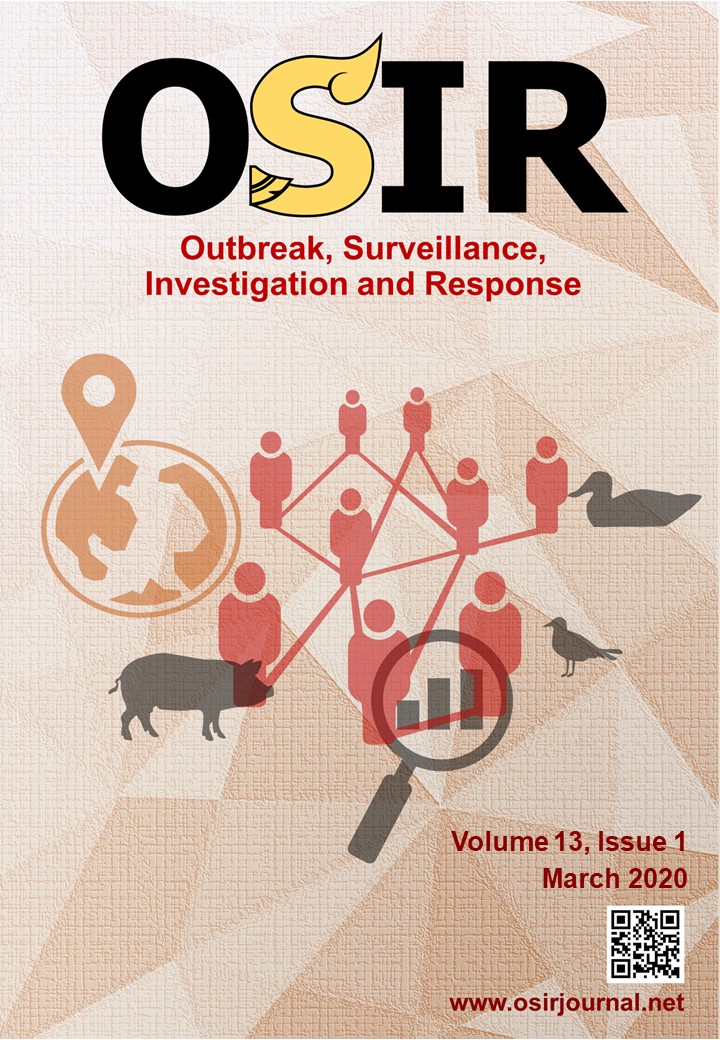Measles Immunity among New Health Personnel at a Faculty of Medicine in Khon Kaen Province, Thailand, 2019
DOI:
https://doi.org/10.59096/osir.v13i1.262853Keywords:
measles, immunity, health personnel, ThailandAbstract
Measles continues to be an important global health problem despite the implementation of vaccination. Health personnel, a high-risk group, are considered to have immunity to measles. We aimed to investigate the measles immunity status among health personnel during pre-placement at the Faculty of Medicine, Khon Kaen University, northeastern Thailand. The sample included health personnel who were examined in the pre-placement program from October 2018 to September 2019. Data collected included sex, age, department, job characteristic (direct or indirect contact with patients), position, measles immunity status, based on serology tests, history of previous infection, and history of immunization. A total of 652 health personnel were included, of which 53.8% tested positive to measles IgG class antibodies, indicating prior exposure to the virus. Among them, the percentage testing positive to measles immunity was 59.5%. Two-thirds of personnel who could not recall their infection or vaccination history had a positive measles immunity status. A consensus for the definition of acceptable presumptive evidence of measles immunity in Thailand according to context must be stipulated, leading to improved management of measles immunization.
References
World Health Organization. Measles [Internet]. 2019 Dec 5 [cited 2020 Feb 16]. <https://bit.ly/3bK4gxx>
Centers for Disease Control and Prevention (U.S.). Measles cases and outbreaks [Internet]. 2020 Feb 3 [cited 2020 Feb 16]. <https://bit.ly/2P1HCY2>
Ministry of Public Health (Thailand). Situation of measles/rubella/CRS 2019 Thailand [Internet]. 2020 [cited 2020 Feb 16]. <https://apps.boe.moph.go.th/measles/>
Shefer A, Atkinson W, Friedman C, Kuhar DT, Mootrey G, Bialek SR, et al. Immunization of health-care personnel: recommendations of the Advisory Committee on Immunization Practices (ACIP). MMWR Recomm Rep. 2011; 60(RR-7):1–45.
Watson JC, Hadler SC, Dykewicz CA, Reef S, Phillips L. Measles, mumps, and rubella--vaccine use and strategies for elimination of measles, rubella, and congenital rubella syndrome and control of mumps: recommendations of the Advisory Committee on Immunization Practices (ACIP). MMWR Recomm Rep. 1998; 47(RR-8):1–57.
Bureau of General Communicable Diseases, Department of Disease Control (Thailand). Recommendation for immunization of healthcare workers. Nonthaburi: Department of; 2015. (In Thai)
Chang HH, Kim SW, Kwon KT, Kim HI, Kim MJ, Ryu SY, et al. Preliminary report of seroprevalence of anti-measles immunoglobulin g among healthcare workers of 6 teaching hospitals of Daegu, Korea in 2019. Infect Chemother. 2019; 51(1):54–7.
Gonwong S, Chuenchitra T, Khantapura P, Islam D, Mason CJ. Measles susceptibility in young Thai men suggests need for young adult measles vaccination: a cross sectional study. BMC Public Health. 2016; 16:309.
Tharmaphornpilas P, Yoocharean P, Rasdjarmrearnsook AO, Theamboonlers A, Poovorawan Y. Seroprevalence of antibodies to measles, mumps, and rubella among Thai population: evaluation of measles/MMR immunization programme. J Health Popul Nutr. 2009; 27(1):80–6.
Gonçalves G, Frade J, Nunes C, Mesquita JR, Nascimento MSJ. Persistence of measles antibodies, following changes in the recommended age for the second dose of MMR-vaccine in Portugal. Vaccine. 2015;33(39):5057–63.
Smetana J, Chlibek R, Hanovcova I, Sosovickova R, Smetanova L, Gal P, et al. Decreasing seroprevalence of measles antibodies after vaccination - possible gap in measles protection in adults in the Czech Republic. PLoS ONE. 2017;12(1):e0170257.
Kang HJ, Han YW, Kim SJ, Kim Y-J, Kim A-R, Kim JA, et al. An increasing, potentially measles-susceptible population over time after vaccination in Korea. Vaccine. 2017; 35(33):4126–32.
Seagle EE, Bednarczyk RA, Hill T, Fiebelkorn AP, Hickman CJ, Icenogle JP, et al. Measles, mumps, and rubella antibody patterns of persistence and rate of decline following the second dose of the MMR vaccine. Vaccine. 2018; 36(6):818–26.
Chokephaibulkit K, Chunsuttiwat S, Varinsathien P. Immunization in Thailand. In: Prommalikit O, Tangsathapornpong A, Thisyakorn U, editors. Vaccine. 2nd ed. Bangkok: Infectious Disease Association of Thailand; 2015. p. 795–811. (In Thai)
Chokephaibulkit K, Lapphra K, Mekmullica J, Narkbunnum T, Tangsathapornpong A. Measles mumps and rubella vaccine. In: Book of vaccine and immunization 2013. Bangkok: Bureau of General Communicable Diseases (Thailand); 2013. p. 119–28. (In Thai)
McLean HQ, Fiebelkorn AP, Temte JL, Wallace GS, Centers for Disease Control and Prevention. Prevention of measles, rubella, congenital rubella syndrome, and mumps, 2013: summary recommendations of the Advisory Committee on Immunization Practices (ACIP). MMWR Recomm Rep. 2013; 62(RR-04):1–34.
Nosocomial Infection Control Group of Thailand. Guideline for managing infectious disease in health personnel. Nonthaburi: Bamrasnaradura Infectious Diseases Institute; 2016. (In Thai)
World Health Organization. Immunological responses to immunization. In: The immunological basis for immunization series: module 7: measles. Geneva: Dept. of Immunization, Vaccines and Biologicals, Family and Child Health, World Health Organization; 2009. p. 10–33.
Bureau of General Communicable Diseases, Department of Disease Control (Thailand). Guidelines for the second dose MR vaccine to boost immunity against measles in children aged 2.5 to 7 years old nationwide, 2015 [Internet]. 2015 [cited 2020 Feb 16]. (In Thai) <https://bit.ly/2Ht1MWH>
Centers for Disease Control and Prevention (U.S.). Questions about measles [Internet]. 2019 May 17 [cited 2020 Feb 17]. <https://bit.ly/2SD3tHv>
Downloads
Published
How to Cite
Issue
Section
License
Copyright (c) 2023 Outbreak, Surveillance, Investigation & Response (OSIR) Journal

This work is licensed under a Creative Commons Attribution-NonCommercial-NoDerivatives 4.0 International License.









